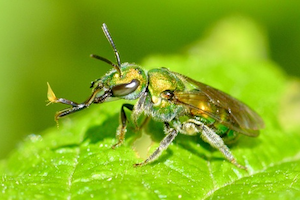Photo Credit: © Bernie Paquette via iNaturalist.org. Creative Commons Attribution 4.0 International (CC BY 4.0) License; https://creativecommons.org/licenses/by/4.0/.
Augochlora pura
Common Name: pure sweat bee
Other Common Names: pure green sweat bee
Animal Guild: Insect
Class > Order > Family: Insecta > Hymenoptera > Halictidae
